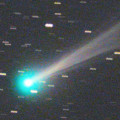
|
It approached to Sun down to 0.23 a.u. and brightened up to 2.5 mag in mid September (Sept. 18, Juan Jose Gonzalez). Now it is 4.5 mag (Sept. 23, Willian Souza). It will fade out rapidly after this. Now it is not observable. It will appear in October in the Southern Hemisphere, or in November in the Northern Hemisphere.
Date(TT) R.A. (2000) Decl. Delta r Elong. m1 Best Time(A, h)
Sept.23 12 51.79 -4 20.2 1.132 0.294 14 3.9 19:20 ( 91,-10)
Sept.30 12 56.79 -13 28.1 1.373 0.466 13 6.4 19:10 ( 85,-18)
|

|
It is expected to brighten up to 7.5 mag in October. Now it is 9.3 mag (Sept. 24, Marco Goiato). It will fade out rapidly after this. In the Northern Hemisphere, it stays observable in good condition. In the Southern Hemisphere, it will be getting higher gradually.
Date(TT) R.A. (2000) Decl. Delta r Elong. m1 Best Time(A, h)
Sept.23 5 38.01 37 20.7 0.384 1.098 93 8.2 4:23 (255, 76)
Sept.30 6 25.04 32 0.6 0.384 1.078 90 7.9 4:29 (274, 73)
|
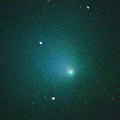
|
It will brighten up to 7.5 mag in October. Now it is 9.5 mag (Sept. 24, Carlos Labordena). It will turn to fade out rapidly after brightening. In the Northern Hemisphere, it will be unobservable in October. In the Southern Hemisphere, it will never be observable after this.
Date(TT) R.A. (2000) Decl. Delta r Elong. m1 Best Time(A, h)
Sept.23 9 11.18 26 25.5 0.901 0.778 47 9.3 4:23 (257, 30)
Sept.30 10 10.76 19 49.3 0.916 0.651 39 8.8 4:29 (260, 22)
|

|
Now it is 9.8 mag (Sept. 16, Marco Goiato). Fading gradually. It locates somewhat low in the Northern Hemisphere. In the Southern Hemisphere, it stays observable in good condition.
Date(TT) R.A. (2000) Decl. Delta r Elong. m1 Best Time(A, h)
Sept.23 1 57.42 -26 48.5 1.864 2.717 140 9.7 1:54 ( 0, 28)
Sept.30 1 38.14 -31 7.9 1.903 2.762 141 9.8 1:07 ( 0, 24)
|
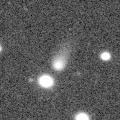
|
It is expected to brighten up to 7 mag in early 2024. Now it is 12.9 mag (Sept. 14, Thomas Lehmann). It will brighten rapidly after this. In the Northern Hemisphere, it is not observable now, but it will appear in November. It locates somewhat low in the Southern Hemisphere. But it will become high in winter. The brightness evolution slowed down since May.
Date(TT) R.A. (2000) Decl. Delta r Elong. m1 Best Time(A, h)
Sept.23 9 43.13 -31 8.5 3.020 2.413 44 11.2 4:23 (302, -9)
Sept.30 9 59.95 -32 14.4 2.940 2.339 44 11.0 4:29 (305, -7)
|

|
It brightened up to 7.8 mag in late July (July 20, Thomas Lehmann). Now it is 11.5 mag (Sept. 9, Chris Wyatt). Fading gradually. It will be unobservable in October. But it will be observable again in November in the Northern Hemisphere, or in December in the Southern Hemisphere.
Date(TT) R.A. (2000) Decl. Delta r Elong. m1 Best Time(A, h)
Sept.23 14 51.78 -14 23.3 2.203 1.661 45 11.4 19:20 ( 66, 8)
Sept.30 14 52.92 -13 32.5 2.370 1.706 38 11.7 19:10 ( 69, 6)
|

|
It brightened up to 8 mag from 2022 summer to 2023 spring. Now it is 11.6 mag (Sept. 24, Osamu Miyazaki). It stays 13 mag for a while. It stays observable in good condition.
Date(TT) R.A. (2000) Decl. Delta r Elong. m1 Best Time(A, h)
Sept.23 6 50.43 -8 14.2 3.810 3.715 77 12.0 4:23 (315, 35)
Sept.30 6 50.36 -8 15.9 3.770 3.779 82 12.0 4:29 (324, 40)
|

|
It brightened very rapidly. It will approach to Earth down to 0.2 a.u. in November, and it is expected to brighten up to 7.5 mag. Now it is 11.9 mag (Sept. 24, Ken-ichi Kadota). It will turn to fade out rapidly after brightening. In the Northern Hemisphere, it will be getting higher gradually. In the Southern Hemisphere, it is not observable now, but it will appear in November.
Date(TT) R.A. (2000) Decl. Delta r Elong. m1 Best Time(A, h)
Sept.23 11 53.71 44 14.5 1.576 1.102 44 12.9 4:23 (223, 11)
Sept.30 11 59.82 44 53.8 1.400 1.036 47 12.4 4:29 (225, 15)
|
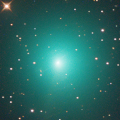
|
It brightened up to 8.4 mag in late July (July 22, Thomas Lehmann). Now it is 11.3 mag (Sept. 18, Chris Wyatt). Fading rapidly. It will be fainter than 18 mag in November. It stays observable in good condition.
Date(TT) R.A. (2000) Decl. Delta r Elong. m1 Best Time(A, h)
Sept.23 22 17.86 -16 13.8 0.715 1.664 150 12.6 22:11 ( 0, 39)
Sept.30 22 23.16 -19 50.0 0.836 1.744 143 13.4 21:48 ( 0, 35)
|

|
Now it is 13.7 mag (July 14, Chris Wyatt). It stays 13 mag for a while. In the Northern Hemisphere, it is not observable now, but it will appear in October. In the Southern Hemisphere, it will be getting higher gradually.
Date(TT) R.A. (2000) Decl. Delta r Elong. m1 Best Time(A, h)
Sept.23 10 40.74 -19 32.6 4.822 3.957 27 13.1 4:23 (285,-14)
Sept.30 10 42.53 -20 53.1 4.812 3.983 30 13.1 4:29 (290, -8)
|
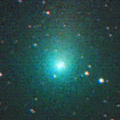
|
It brightened up to 9.5 mag from last winter to early spring (Jan. 30, Katsumi Yoshimoto). Now it is 12.8 mag (Sept. 18, Chris Wyatt). It will fade out rapidly after this. It stays observable in good condition.
Date(TT) R.A. (2000) Decl. Delta r Elong. m1 Best Time(A, h)
Sept.23 23 11.98 5 50.6 2.173 3.159 167 13.1 23:03 ( 0, 61)
Sept.30 23 2.33 2 43.1 2.264 3.223 159 13.3 22:26 ( 0, 58)
|
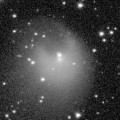
|
It returns for the first time in 70 years. It will brighten up to 4.5 mag in 2024 spring. It suddenly brightened in outburst by 5 mag up to 11.5 mag on July 20 (E. Tamas, Francois Kugel). Now it is 11.9 mag (Sept. 11, Katsumi Yoshimoto). It will brighten rapidly after this. In the Northern Hemisphere, it stays observable in good condition. In the Southern Hemisphere, it will be unobservable in October.
Date(TT) R.A. (2000) Decl. Delta r Elong. m1 Best Time(A, h)
Sept.23 17 18.62 48 18.9 3.154 3.197 83 13.2 19:20 (129, 63)
Sept.30 17 19.78 47 3.0 3.111 3.118 81 13.3 19:10 (125, 60)
|

|
It brightened up to 8.3 mag in 2021-2022 winter (Jan. 6, 2022, Toshiyuki Takahashi). Now it is 13.2 mag (July 14, Chris Wyatt). It stays 14 mag for a while. In the Northern Hemisphere, it is not observable now, but it will appear in November. In the Southern Hemisphere, it will be getting higher gradually.
Date(TT) R.A. (2000) Decl. Delta r Elong. m1 Best Time(A, h)
Sept.23 10 41.92 -36 4.7 7.116 6.384 40 13.6 4:23 (300,-22)
Sept.30 10 47.28 -36 54.4 7.153 6.429 40 13.7 4:29 (303,-18)
|

|
Now it is 13.4 mag (Sept. 16, Chris Wyatt). Fading slowly. In the Northern Hemisphere, it is not observable now. In the Southern Hemisphere, it stays observable in good condition. It was expected to brighten up to 10 mag from spring to summer. However, it was fainter than originally expected.
Date(TT) R.A. (2000) Decl. Delta r Elong. m1 Best Time(A, h)
Sept.23 11 43.84 -75 5.3 3.460 3.350 75 13.7 4:23 (342,-38)
Sept.30 11 49.09 -75 27.2 3.529 3.377 73 13.8 4:29 (342,-37)
|
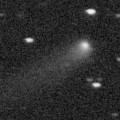
|
Now it is 14.1 mag (Sept. 11, Ken-ichi Kadota). Fading slowly. In the Northern Hemisphere, it stays observable in good condition. In the Southern Hemisphere, it will be getting lower gradually after this, and it will be unobservable in January.
Date(TT) R.A. (2000) Decl. Delta r Elong. m1 Best Time(A, h)
Sept.23 0 45.26 6 46.5 2.442 3.425 166 13.8 0:42 ( 0, 62)
Sept.30 0 26.78 6 16.8 2.447 3.447 176 13.8 23:49 ( 0, 61)
|
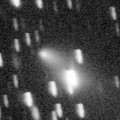
|
Now it is 14.1 mag (Sept. 8, Thomas Lehmann). It will fade out rapidly after this. In the Northern Hemisphere, it stays observable in good condition. In the Southern Hemisphere, it will never be observable after this.
Date(TT) R.A. (2000) Decl. Delta r Elong. m1 Best Time(A, h)
Sept.23 2 26.28 59 50.7 1.281 1.915 113 14.0 2:23 (180, 65)
Sept.30 2 10.89 63 32.3 1.292 1.950 115 14.1 1:40 (180, 61)
|

|
Now it is 15.0 mag (Sept. 5, W. Hasubick). In the Northern Hemisphere, it stays observable in good condition. It locates somewhat low in the Southern Hemisphere.
Date(TT) R.A. (2000) Decl. Delta r Elong. m1 Best Time(A, h)
Sept.23 8 25.05 21 52.5 6.641 6.138 56 14.0 4:23 (268, 37)
Sept.30 8 28.91 21 37.6 6.546 6.140 62 14.0 4:29 (272, 43)
|

|
The ATLAS search program detected its cometary activity in April. It continues to be brightening even after the perihelion passage. Now it is 14.0 mag (Sept. 18, Chris Wyatt). It will fade out rapidly after this. It will be fainter than 18 mag in January. In the Southern Hemisphere, it stays observable in good condition.
Date(TT) R.A. (2000) Decl. Delta r Elong. m1 Best Time(A, h)
Sept.23 23 41.85 -27 15.6 2.139 3.066 152 14.2 23:34 ( 0, 28)
Sept.30 23 38.31 -26 54.3 2.200 3.100 148 14.4 23:03 ( 0, 28)
|
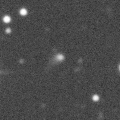
|
Now it is 15.6 mag (July 8, Thomas Lehmann). Brightening slowly. In the Northern Hemisphere, it will be getting higher gradually. It locates somewhat low in the Southern Hemisphere. But it will become high in autumn. It is expected to brighten up to 12 mag from 2024 to 2025.
Date(TT) R.A. (2000) Decl. Delta r Elong. m1 Best Time(A, h)
Sept.23 9 35.29 4 3.2 5.596 4.817 35 14.5 4:23 (274, 13)
Sept.30 9 37.57 4 12.8 5.479 4.780 41 14.4 4:29 (279, 19)
|
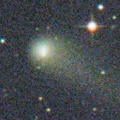
|
It brightened up to 11.1 mag in early 2022 (Mar. 31, 2022, F. Kugel, J.-G. Bosch, J. Nicolas). Now it is 14.1 mag (Sept. 5, Ken-ichi Kadota). It stays 15 mag for a while. In the Northern Hemisphere, it will be getting lower gradually. But it will be getting higher again after December. In the Southern Hemisphere, it will be unobservable in October.
Date(TT) R.A. (2000) Decl. Delta r Elong. m1 Best Time(A, h)
Sept.23 15 39.72 17 26.8 6.183 5.702 57 14.4 19:20 ( 86, 37)
Sept.30 15 44.60 17 4.8 6.279 5.739 53 14.5 19:10 ( 88, 34)
|
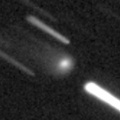
|
Now it is 14.8 mag (Aug. 18, Ken-ichi Kadota). It stays 14 mag for a while. It will be unobservable in October in the Southern Hemisphere, or in November in the Northern Hemisphere. But it will be observable again in December. It is expected to brighten up to 12.5 mag in 2024 spring. At the high light, it will be observable in excellent condition in the Southern Hemisphere, but it will be low in the Northern Hemisphere.
Date(TT) R.A. (2000) Decl. Delta r Elong. m1 Best Time(A, h)
Sept.23 15 7.52 0 55.6 3.814 3.221 47 14.7 19:20 ( 76, 21)
Sept.30 15 7.69 -0 32.3 3.867 3.183 41 14.7 19:10 ( 77, 16)
|

|
Now it is 13.9 mag (Sept. 5, Ken-ichi Kadota). It will fade out rapidly after this. It will be fainter than 18 mag in December. It stays observable in good condition.
Date(TT) R.A. (2000) Decl. Delta r Elong. m1 Best Time(A, h)
Sept.23 19 41.90 -1 57.8 1.608 2.238 116 14.9 19:35 ( 0, 53)
Sept.30 19 48.21 -2 21.9 1.699 2.262 111 15.2 19:14 ( 0, 53)
|

|
It will brighten up to 14 mag from 2024 to 2025. Now it is 15.2 mag (July 22, ATLAS Chile). It stays 15 mag for a while. In the Northern Hemisphere, it is not observable now, but it will appear in November. It locates somewhat low in the Southern Hemisphere. But it will become high in autumn.
Date(TT) R.A. (2000) Decl. Delta r Elong. m1 Best Time(A, h)
Sept.23 10 47.76 -28 49.9 6.469 5.659 33 15.1 4:23 (292,-20)
Sept.30 10 54.71 -29 18.1 6.437 5.635 34 15.1 4:29 (296,-15)
|

|
Now it is 14.3 mag (July 7, Thomas Lehmann). Fading slowly. In the Northern Hemisphere, it is not observable now. It stays extremely low in the Southern Hemisphere. But it will become high in winter.
Date(TT) R.A. (2000) Decl. Delta r Elong. m1 Best Time(A, h)
Sept.23 12 18.34 -49 17.0 3.191 2.655 49 15.1 19:20 ( 50,-36)
Sept.30 12 39.46 -49 22.4 3.288 2.706 47 15.2 19:10 ( 50,-36)
|
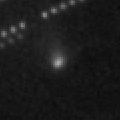
|
It brightened very rapidly. Now it is 15.2 mag (Aug. 23, ATLAS South Africa). It will fade out rapidly after this. It will be fainter than 18 mag in December. In the Northern Hemisphere, it is not observable now, but it will appear in November. In the Southern Hemisphere, it will be unobservable in October.
Date(TT) R.A. (2000) Decl. Delta r Elong. m1 Best Time(A, h)
Sept.23 14 9.40 -21 6.7 2.734 2.048 38 15.2 19:20 ( 67, -4)
Sept.30 14 13.67 -19 32.7 2.837 2.057 31 15.4 19:10 ( 70, -5)
|
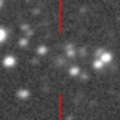
|
Now it is 14.6 mag (Aug. 5, J. L. Virlichie, P. Traverse, H. Roy, G. Houdin). Fading slowly. In the Northern Hemisphere, it will be unobservable in January. In the Southern Hemisphere, it stays observable in good condition.
Date(TT) R.A. (2000) Decl. Delta r Elong. m1 Best Time(A, h)
Sept.23 18 14.88 -33 45.1 2.688 2.929 93 15.3 19:20 ( 16, 19)
Sept.30 18 22.40 -34 2.9 2.786 2.935 88 15.4 19:10 ( 18, 18)
|

|
It approached to Earth down to 0.29 a.u. in early February, and it brightened up to 4.5 mag (Feb. 1, Juan Jose Gonzalez). Now it is 14.8 mag (Aug. 27, Taras Prystavski). Fading slowly. In the Northern Hemisphere, it will be unobservable in October. In the Southern Hemisphere, it stays observable in good condition.
Date(TT) R.A. (2000) Decl. Delta r Elong. m1 Best Time(A, h)
Sept.23 6 37.91 -45 43.2 3.595 3.616 83 15.4 4:23 (338, 4)
Sept.30 6 34.76 -48 12.7 3.619 3.690 86 15.5 4:29 (345, 4)
|

|
It has not been observed yet in this apparition. It was expected to brighten rapidly up to 15 mag in summer. But actually, it is not detected, fainter than 19 mag (Aug. 12, Martin Masek). Fading slowly. It locates somewhat low in the Northern Hemisphere. In the Southern Hemisphere, it will be getting lower gradually after this, and it will be unobservable in January.
Date(TT) R.A. (2000) Decl. Delta r Elong. m1 Best Time(A, h)
Sept.23 17 46.23 -26 21.6 1.794 2.017 87 15.4 19:20 ( 25, 24)
Sept.30 17 59.17 -25 44.6 1.856 2.008 83 15.4 19:10 ( 26, 24)
|
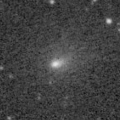
|
Now it is 15.4 mag (Sept. 1, Ken-ichi Kadota). Fading rapidly. It will be fainter than 18 mag in November. It locates somewhat low in the Northern Hemisphere. In the Southern Hemisphere, it stays observable in good condition.
Date(TT) R.A. (2000) Decl. Delta r Elong. m1 Best Time(A, h)
Sept.23 18 49.77 -21 26.2 1.424 1.907 102 15.6 19:20 ( 10, 33)
Sept.30 18 50.45 -25 12.8 1.611 1.971 95 16.0 19:10 ( 14, 28)
|

|
It will approach to Sun down to 0.4 a.u. in late September in 2024, and it is expected to brighten up to 0 mag. Now it is 15.3 mag (Sept. 10, A. Ivanov et al.). Brightening slowly. It will be unobservable in October. But it will be observable again in November in the Northern Hemisphere, or in December in the Southern Hemisphere. At the high light, in the Northern Hemisphere, it will be observable in good condition after the perihelion passage. In the Southern Hemisphere, it will be observable in the low sky before and after the perihelion passage.
Date(TT) R.A. (2000) Decl. Delta r Elong. m1 Best Time(A, h)
Sept.23 14 11.40 -1 19.9 6.124 5.316 33 15.7 19:20 ( 82, 8)
Sept.30 14 14.04 -1 49.7 6.110 5.244 27 15.6 19:10 ( 84, 5)
|
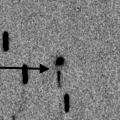
|
David Rankin detected its cometary activity in June. Now it is 15.9 mag (Sept. 9, Ken-ichi Kadota). It stays 16 mag for a while. It stays observable in good condition.
Date(TT) R.A. (2000) Decl. Delta r Elong. m1 Best Time(A, h)
Sept.23 22 7.25 -3 58.8 1.339 2.276 152 15.8 21:59 ( 0, 51)
Sept.30 22 5.50 -4 8.9 1.358 2.253 145 15.8 21:30 ( 0, 51)
|

|
It will turn to fade out rapidly after brightening. It will be fainter than 18 mag in January. It will be unobservable in October. But it will be observable again in November.
Date(TT) R.A. (2000) Decl. Delta r Elong. m1 Best Time(A, h)
Sept.23 9 29.84 13 57.2 1.272 0.802 39 16.3 4:23 (267, 20)
Sept.30 10 14.90 8 36.3 1.181 0.657 33 15.8 4:29 (270, 15)
|

|
Now it is 15.6 mag (Sept. 9, Thomas Lehmann). Fading slowly. It stays observable in good condition.
Date(TT) R.A. (2000) Decl. Delta r Elong. m1 Best Time(A, h)
Sept.23 0 30.04 -7 36.6 2.672 3.662 169 15.9 0:26 ( 0, 48)
Sept.30 0 25.38 -7 57.9 2.688 3.678 169 15.9 23:49 ( 0, 47)
|
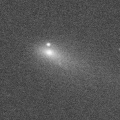
|
It brightened up to 12.8 mag in spring (Mar. 8, Taras Prystavski). Now it is 15.5 mag (Sept. 5, Masayoshi Yoshimi). It will fade out rapidly after this. It will be fainter than 18 mag in November. It stays observable in good condition.
Date(TT) R.A. (2000) Decl. Delta r Elong. m1 Best Time(A, h)
Sept.23 1 13.18 -4 53.1 1.631 2.599 160 16.0 1:09 ( 0, 50)
Sept.30 1 6.23 -5 20.5 1.652 2.637 166 16.2 0:35 ( 0, 50)
|

|
It is expected to brighten up to 14.5 mag in winter. Now it is 17.0 mag (Sept. 10, ATLAS-HKO, Haleakala). Brightening slowly. It stays observable in good condition.
Date(TT) R.A. (2000) Decl. Delta r Elong. m1 Best Time(A, h)
Sept.23 3 31.57 14 45.2 2.001 2.706 125 16.2 3:27 ( 0, 70)
Sept.30 3 32.42 15 1.9 1.897 2.670 131 16.0 3:00 ( 0, 70)
|

|
It is expected to brighten up to 7 mag, and it will be observable in good condition in winter. Now it is 18.9 mag (Sept. 11, W. Hasubick). Brightening rapidly. In the Northern Hemisphere, it stays observable in good condition. It locates somewhat low in the Southern Hemisphere. But it will become high in winter.
Date(TT) R.A. (2000) Decl. Delta r Elong. m1 Best Time(A, h)
Sept.23 5 40.44 21 11.0 1.256 1.661 93 16.6 4:23 (306, 69)
Sept.30 6 0.74 21 33.3 1.163 1.613 96 16.1 4:29 (312, 71)
|
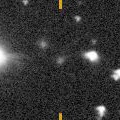
|
It is expected to brighten up to 14 mag in 2024 summer. At the high light, it is not observable in the Northern Hemisphere. Now it is 16.8 mag (Sept. 8, A. Diepvens). It stays 16 mag for a while. It stays observable in good condition.
Date(TT) R.A. (2000) Decl. Delta r Elong. m1 Best Time(A, h)
Sept.23 3 25.65 -5 28.6 3.367 4.061 127 16.2 3:21 ( 0, 50)
Sept.30 3 21.66 -7 40.7 3.249 4.013 134 16.1 2:50 ( 0, 47)
|
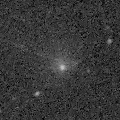
|
Very large comet. It is expected to brighten up to 13 mag in 2031. Now it is 15.7 mag (Aug. 19, Thomas Lehmann). It stays 16 mag for a while. In the Northern Hemisphere, it is not observable now. In the Southern Hemisphere, it stays observable in good condition. In the Northern Hemisphere, it is not observable until 2030.
Date(TT) R.A. (2000) Decl. Delta r Elong. m1 Best Time(A, h)
Sept.23 3 31.75 -63 56.9 16.909 17.202 105 16.2 3:26 ( 0, -9)
Sept.30 3 30.24 -64 21.1 16.893 17.177 104 16.2 2:57 ( 0, -9)
|

|
Now it is 16.1 mag (Aug. 23, ATLAS South Africa). Fading slowly. It will be fainter than 18 mag in December. It locates somewhat low in the Northern Hemisphere. In the Southern Hemisphere, it will be getting lower gradually after this, and it will be unobservable in December.
Date(TT) R.A. (2000) Decl. Delta r Elong. m1 Best Time(A, h)
Sept.23 17 34.37 -21 32.7 2.814 2.898 84 16.2 19:20 ( 30, 27)
Sept.30 17 42.27 -21 43.9 2.948 2.938 79 16.4 19:10 ( 32, 26)
|
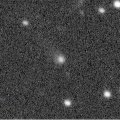
|
Now it is 16.5 mag (Apr. 10, Michael Jager). It stays 16 mag for a while. In the Northern Hemisphere, it is not observable now, but it will appear in October. In the Southern Hemisphere, it stays observable in good condition.
Date(TT) R.A. (2000) Decl. Delta r Elong. m1 Best Time(A, h)
Sept.23 9 26.13 -31 50.2 4.298 3.704 48 16.4 4:23 (305, -7)
Sept.30 9 29.97 -34 2.8 4.249 3.703 51 16.3 4:29 (310, -3)
|
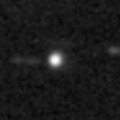
|
Now it is 16.4 mag (Sept. 6, A. Diepvens). Fading slowly. It will be fainter than 18 mag in January. It stays observable in good condition. It was very faint as 21.5 mag in 2021. It seems to be bright temporarily in outburst.
Date(TT) R.A. (2000) Decl. Delta r Elong. m1 Best Time(A, h)
Sept.23 21 8.09 -11 53.7 3.770 4.549 136 16.5 21:00 ( 0, 43)
Sept.30 21 6.91 -11 58.4 3.863 4.562 129 16.6 20:32 ( 0, 43)
|
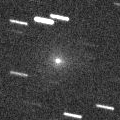
|
It was expected to brighten up to 11 mag in July. But actually, it was fainter than originally expected. Now it is 16.1 mag (Sept. 1, Ken-ichi Kadota). Fading rapidly. It will be fainter than 18 mag in October. In the Northern Hemisphere, it will be getting higher gradually. It locates somewhat low in the Southern Hemisphere.
Date(TT) R.A. (2000) Decl. Delta r Elong. m1 Best Time(A, h)
Sept.23 9 21.80 5 30.6 1.996 1.375 39 16.5 4:23 (275, 17)
Sept.30 9 38.28 3 41.1 2.027 1.441 41 17.0 4:29 (279, 19)
|

|
It is expected to brighten up to 15 mag from autumn to winter. Now it is 18.7 mag (Sept. 4, ATLAS Chile). Brightening slowly. In the Northern Hemisphere, it is not observable now, but it will appear in October. In the Southern Hemisphere, it stays observable in good condition.
Date(TT) R.A. (2000) Decl. Delta r Elong. m1 Best Time(A, h)
Sept.23 2 38.53 -59 3.7 1.354 1.979 113 17.0 2:34 ( 0, -4)
Sept.30 2 24.17 -58 56.6 1.316 1.952 114 16.7 1:52 ( 0, -4)
|
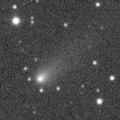
|
Now it is 16.1 mag (Sept. 8, ATLAS Chile). Fading slowly. It will be fainter than 18 mag in November. In the Northern Hemisphere, it will never be observable after this. In the Southern Hemisphere, it will be getting lower gradually.
Date(TT) R.A. (2000) Decl. Delta r Elong. m1 Best Time(A, h)
Sept.23 15 28.02 -39 27.0 2.915 2.602 62 16.7 19:20 ( 42, -3)
Sept.30 15 42.42 -39 57.6 3.000 2.621 58 16.8 19:10 ( 42, -3)
|
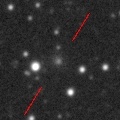
|
Now it is 16.9 mag (Aug. 24, ATLAS Chile). It stays 17 mag for a while. In the Southern Hemisphere, it will be getting lower gradually after this, and it will be unobservable in December.
Date(TT) R.A. (2000) Decl. Delta r Elong. m1 Best Time(A, h)
Sept.23 18 4.05 -11 59.1 2.302 2.536 91 16.7 19:20 ( 27, 39)
Sept.30 18 11.54 -12 11.8 2.371 2.520 86 16.8 19:10 ( 29, 38)
|

|
Very far object. Now it is 17.0 mag (Aug. 26, Jean-Claude Merlin). It stays 17 mag for a while. In the Northern Hemisphere, it is not observable now. In the Southern Hemisphere, it stays observable in good condition.
Date(TT) R.A. (2000) Decl. Delta r Elong. m1 Best Time(A, h)
Sept.23 5 39.68 -73 52.2 10.242 10.317 91 16.8 4:23 (355,-19)
Sept.30 5 33.82 -74 33.9 10.252 10.316 90 16.8 4:29 (358,-20)
|
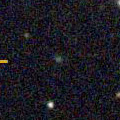
|
Now it is 16.6 mag (Sept. 9, ATLAS-HKO, Haleakala). It stays 17 mag for a while. In the Northern Hemisphere, it stays observable in good condition. It stays extremely low in the Southern Hemisphere.
Date(TT) R.A. (2000) Decl. Delta r Elong. m1 Best Time(A, h)
Sept.23 5 0.27 39 15.0 6.459 6.722 100 16.9 4:23 (234, 82)
Sept.30 5 1.56 39 37.6 6.353 6.718 107 16.9 4:29 (181, 85)
|

|
It brightened up to 14.1 mag in 2022 spring (Mar. 22, 2022, Chris Wyatt). It was expected to brighten up to 13 mag. But actually, it was fainter than originally expected. Now it is 16.3 mag (Sept. 7, ATLAS South Africa). Fading slowly. It will be fainter than 18 mag in January. It stays observable in good condition.
Date(TT) R.A. (2000) Decl. Delta r Elong. m1 Best Time(A, h)
Sept.23 2 38.10 -2 38.1 4.458 5.265 139 16.9 2:34 ( 0, 52)
Sept.30 2 31.59 -2 39.5 4.441 5.312 147 16.9 2:00 ( 0, 52)
|

|
Now it is 16.7 mag (Aug. 28, Ken-ichi Kadota). It stays 17 mag for a while. It stays observable in good condition.
Date(TT) R.A. (2000) Decl. Delta r Elong. m1 Best Time(A, h)
Sept.23 4 58.80 -10 50.8 7.188 7.503 104 17.0 4:23 (350, 44)
Sept.30 4 59.23 -11 9.9 7.069 7.471 109 17.0 4:27 ( 0, 44)
|
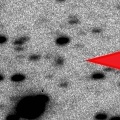
|
Now it is 17.7 mag (Sept. 10, Jean-Claude Merlin). It stays 17 mag for a while. It will be unobservable in October in the Northern Hemisphere, or in November in the Southern Hemisphere. But it will be observable again in December in the Southern Hemisphere. It stays 16 mag in the Southern sky for a long time from 2024 to 2025.
Date(TT) R.A. (2000) Decl. Delta r Elong. m1 Best Time(A, h)
Sept.23 16 23.64 -39 39.4 6.609 6.376 72 17.1 19:20 ( 34, 4)
Sept.30 16 23.20 -39 34.7 6.693 6.347 65 17.2 19:10 ( 36, 2)
|

|
It brightened up to 13.4 mag in last summer (July 7, 2022, Giuseppe Pappa). Now it is 17.4 mag (Sept. 7, Thomas Lehmann). It stays 18 mag for a while. In the Northern Hemisphere, it will be getting lower gradually. But it will be getting higher again after November. In the Southern Hemisphere, it will be unobservable in October.
Date(TT) R.A. (2000) Decl. Delta r Elong. m1 Best Time(A, h)
Sept.23 15 23.87 29 49.0 5.083 4.616 57 17.2 19:20 (102, 39)
Sept.30 15 26.37 29 32.5 5.178 4.664 54 17.3 19:10 (103, 36)
|

|
It is expected to brighten up to 8.5 mag from January to February. Now it is 19.8 mag (Sept. 8, F. Kugel, J. Nicolas). Brightening rapidly. It stays observable in good condition.
Date(TT) R.A. (2000) Decl. Delta r Elong. m1 Best Time(A, h)
Sept.23 2 53.80 20 58.5 1.135 1.955 132 17.9 2:49 ( 0, 76)
Sept.30 2 57.88 21 14.5 1.041 1.907 137 17.4 2:26 ( 0, 76)
|
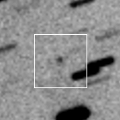
|
Now it is 17.5 mag (Sept. 9, F. Kugel, J. Nicolas). It stays 17 mag for a while. In the Northern Hemisphere, it stays observable in good condition. In the Southern Hemisphere, it is not observable now, but it will appear in November.
Date(TT) R.A. (2000) Decl. Delta r Elong. m1 Best Time(A, h)
Sept.23 1 40.13 57 58.1 3.912 4.476 118 17.5 1:37 (180, 67)
Sept.30 1 20.11 58 23.9 3.831 4.457 122 17.4 0:50 (180, 66)
|

|
Now it is 18.0 mag (Sept. 9, ATLAS-HKO, Haleakala). It stays 17 mag for a while. In the Northern Hemisphere, it stays observable in good condition. It stays extremely low in the Southern Hemisphere.
Date(TT) R.A. (2000) Decl. Delta r Elong. m1 Best Time(A, h)
Sept.23 5 6.71 39 9.6 5.131 5.391 99 17.5 4:23 (239, 81)
Sept.30 5 8.59 39 7.8 5.006 5.368 105 17.4 4:29 (199, 86)
|

|
Now it is 17.3 mag (Aug. 28, Taras Prystavski). It stays 18 mag for a while. It stays observable in good condition.
Date(TT) R.A. (2000) Decl. Delta r Elong. m1 Best Time(A, h)
Sept.23 3 58.52 7 42.3 2.425 3.047 119 17.5 3:54 ( 0, 63)
Sept.30 3 59.18 7 16.5 2.360 3.058 125 17.4 3:27 ( 0, 62)
|
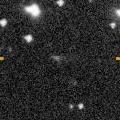
|
First return of a new periodic comet which brightened up to 15 mag in 2008. Now it is 17.4 mag (Aug. 3, Ken-ichi Kadota). Fading gradually. It will be fainter than 18 mag in November. It stays observable in good condition.
Date(TT) R.A. (2000) Decl. Delta r Elong. m1 Best Time(A, h)
Sept.23 4 7.13 17 42.8 2.009 2.612 116 17.5 4:02 ( 0, 73)
Sept.30 4 8.86 16 31.2 1.959 2.639 122 17.5 3:37 ( 0, 72)
|

|
Now it is 17.5 mag (Sept. 7, P.-J. Dekelver). It stays 18 mag for a while. In the Northern Hemisphere, it will be getting lower gradually. It stays extremely low in the Southern Hemisphere.
Date(TT) R.A. (2000) Decl. Delta r Elong. m1 Best Time(A, h)
Sept.23 15 31.75 24 42.7 3.363 2.942 57 17.8 19:20 ( 95, 39)
Sept.30 15 43.79 22 49.1 3.413 2.955 55 17.8 19:10 ( 94, 37)
|

|
It brightened up to 14 mag from 2020 to 2021. Now it is 17.9 mag (Aug. 24, W. Hasubick). It stays 18 mag for a while. It stays observable in good condition.
Date(TT) R.A. (2000) Decl. Delta r Elong. m1 Best Time(A, h)
Sept.23 3 6.89 4 2.9 3.993 4.730 132 17.9 3:02 ( 0, 59)
Sept.30 3 4.50 3 47.1 3.933 4.742 139 17.9 2:32 ( 0, 59)
|

|
Now it is 17.7 mag (Sept. 5, Jean-Claude Merlin). Fading slowly. It will be fainter than 18 mag in October. It stays observable in good condition.
Date(TT) R.A. (2000) Decl. Delta r Elong. m1 Best Time(A, h)
Sept.23 22 47.95 -18 33.0 2.122 3.061 154 17.9 22:40 ( 0, 37)
Sept.30 22 45.12 -19 9.2 2.173 3.066 147 18.0 22:10 ( 0, 36)
|

|
It returned for the first time in 68 years. It will brighten up to 7.5 mag in 2024 summer. Now it is 20.5 mag (Sept. 10, Alan Hale). It will brighten rapidly after this. It stays observable in good condition. At the high light, it locates low in the Northern Hemisphere, or it is not observable in the Southern Hemisphere.
Date(TT) R.A. (2000) Decl. Delta r Elong. m1 Best Time(A, h)
Sept.23 4 28.15 -17 20.7 3.241 3.727 111 19.6 4:23 ( 0, 38)
Sept.30 4 27.78 -18 2.4 3.102 3.659 116 19.4 3:55 ( 0, 37)
|
|
![]()
 C/2022 W3 ( Leonard )
C/2022 W3 ( Leonard ) C/2023 A3 ( Tsuchinshan-ATLAS )
C/2023 A3 ( Tsuchinshan-ATLAS ) P/2023 KF3
P/2023 KF3 (3200) Phaethon
(3200) Phaethon 117P/Helin-Roman-Alu 1
117P/Helin-Roman-Alu 1 71P/Clark
71P/Clark 32P/Comas Sola
32P/Comas Sola 62P/Tsuchinshan 1
62P/Tsuchinshan 1 C/2022 S4 ( Lemmon )
C/2022 S4 ( Lemmon ) C/2014 UN271 ( Bernardinelli-Bernstein )
C/2014 UN271 ( Bernardinelli-Bernstein ) 81P/Wild 2
81P/Wild 2 C/2022 A3 ( Lemmon-ATLAS )
C/2022 A3 ( Lemmon-ATLAS ) P/2023 M4 ( ATLAS )
P/2023 M4 ( ATLAS ) 185P/Petriew
185P/Petriew 226P/Pigott-LINEAR-Kowalski
226P/Pigott-LINEAR-Kowalski 77P/Longmore
77P/Longmore 219P/LINEAR
219P/LINEAR C/2019 E3 ( ATLAS )
C/2019 E3 ( ATLAS ) C/2021 S4 ( Tsuchinshan )
C/2021 S4 ( Tsuchinshan ) C/2020 Y2 ( ATLAS )
C/2020 Y2 ( ATLAS ) C/2022 QE78 ( ATLAS )
C/2022 QE78 ( ATLAS ) C/2023 F3 ( ATLAS )
C/2023 F3 ( ATLAS ) C/2020 R7 ( ATLAS )
C/2020 R7 ( ATLAS ) 144P/Kushida
144P/Kushida C/2022 U1 ( Leonard )
C/2022 U1 ( Leonard ) C/2022 U3 ( Bok )
C/2022 U3 ( Bok ) 170P/Christensen
170P/Christensen 465P/2023 L1 ( Hill )
465P/2023 L1 ( Hill ) C/2022 U4 ( Bok )
C/2022 U4 ( Bok ) 246P/NEAT
246P/NEAT 287P/Christensen
287P/Christensen 13P/Olbers
13P/Olbers![]()






















































